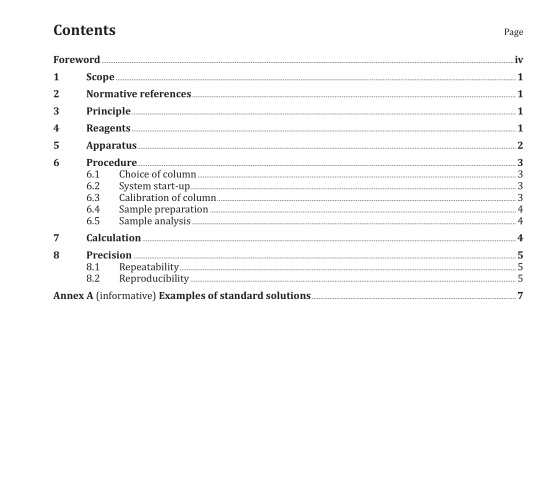ISO 10504:2013 pdf download.Starch derivatives — Determination of the composition of glucose syrups, fructose syrups and hydrogenated glucose syrups — Method using high- performance liquid chromatography
5 Apparatus
5.1 Liquid chromatograph; equipped with the following.
5.1.1 Pump, pulseless, that delivers a constant flow, at the rate required.
5.1.2 Differential refractometer, thermostatically controlled.
5.1.3 Thermostatically controlled column oven, capable of maintaining the column at temperatures up to 95 °C, to within ± 0,5 °C.
5.2 Sample injector, comprising a loop injector (manual or part of autosampler) with a capacity of 20 µl or less.
5.3 Integrator, comprising an electronic integrator with calculating and recording capabilities,compatible with the voltage output of the detector.
5.4 Separation column, comprising a pre-packed cation-exchange column in the form best suited for the analysis. The recommended resin is 6 % to 8 % cross-linked sulfonated polystyrene divinylbenzene with a bead diameter of 9 µm to 25 µm.
NOTE Acceptable columns are available from several major column suppliers.
5.5 Guard columns, custom-prepared dual-cartridge system, inserted unheated in-line, to demineralize the sample. 2)
5.6 Sample filtration system, comprising a syringe to which suitable membrane disc filters can be ttached. These should be of 0,45 µm pore size.
Commercially available syrups are usually highly refined, and a 0,45 µm filter is suitable. However, if blockage of the chromatograph is too frequent, a 0,22 µm filter should be used.
6 Procedure
6.1 Choice of column
For general applications, a cation-exchange resin in the calcium form should be used, in particular for fructose syrups and hydrogenated glucose syrups. However, the separation of maltose at a high content from maltotriose is difficult when the maltotriose content is about 6 % or more. In such instances better resolution is achieved with a cation-exchange resin in either the potassium or sodium form.
6.2 System start-up Install the column in the oven, and connect the guard columns (5.5) (if used) to the inlet. It is not necessary to heat the guard columns. Connect the injector to the inlet of the column (or guard columns, if used), and connect the outlet of the column to the detector inlet. Arrange that the detector effluent goes to waste. Start the pump at a rate of 0,1 ml/min, and pass the solvent through the column. Set the correct temperature for the column according to the supplier’s recommendations. Enter the control parameters into the integrator. When the column temperature is stable, increase the solvent flow rate to 0,5 ml/min and purge the reference cell. Refer to the refractometer instruction manual to set the detector for correct measurement of the signal from the sample cell. Set the required attenuation.
6.3 Calibration of column
6.3.1 In accordance with the method specified in ISO 5381, determine the water content of every separate substance to be used for preparing the mixed primary standard solutions (see Annex A). For higher polyols (tri-itol and above), no commercial standards are available.
6.3.2 Prepare a standard solution of each separate substance (see 4.2) and, using the same conditions as those to be used for the analysis, inject an aliquot portion several times into the column. At least three results, based on integrator response, should show a variation of ± 0,1 % or less for the major constituent. Calculate an average result for all components. NOTE For the single primary substances, an assumption is made that each sugar has the same relative response, and that the normalized area percentage figures reflect the true analysis. To obtain the required level of higher molecular weight species, a dextrin, or a fraction especially prepared from a starch hydrolysate, can be used.
6.3.3 Prepare mixtures of the single substances to give compositions as close as possible to those of the samples to be analysed. These should be prepared at the chosen concentration (see 4.2).
NOTE An example is given in Annex A.
6.3.4 Inject the chosen aliquot portion twice into the chromatograph. The quantity injected shall be large enough to give measurable peaks of minor constituents, while the major component is within the detector range for linear response.ISO 10504 pdf download.
